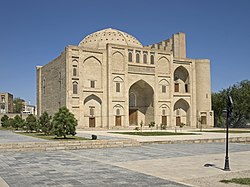| Khanqah Nodir Devon Begi | |
|---|---|
| Native name Uzbek: Nodir devonbegi xonaqohi | |
 Khanaka (Khanqah) Nodir Devon Begi. Bukhara | |
| Type | Khanqah |
| Location | The city of Bukhara |
| Nearest city | Bukhara |
| Coordinates | 39°46′23″N 64°25′11″E / 39.77308°N 64.41971°E |
| Built for | Mosque |
| Original use | Nodir Devon Begi |
| Restored | 1914-1916 |
| Restored by | Sayyid Mir Muhammad Alim Khan |
Nodir Devonbegi (Uzbek: Nodir devonbegi xonaqohi) is a historical memorial in Bukhara, Uzbekistan. It was established by Nodir Devonbegi (Nodir Mirzo Togay ibn Sultan), the vizier and brother of the ruler of Bukhara, Imamquli Khan, in 1620–1621. The Khanaka has been included in the national list of intangible cultural heritage objects of Uzbekistan.
History
The Nodir Devonbegi Khanaka was constructed in 1620 with a pool at the same time.
[1]
[2] The Khanaka primarily served as a residence for
dervishes, with the
Labi Hovuz located nearby, which was dug in 1620.
[1]
[3]
The Khanaka is a multi-roomed structure with two large minaret-like towers forming its entrance. It has 28 small domes on the roof. The central dome hall of the Nodir Devonbegi Khanaka has doors on three sides and a
mihrab (prayer niche) on the west side. The corners of the Khanaka have cells.
For a certain period, the Khanaka served as a
madrasa and a shelter and
mosque for those coming from distant regions.
[4] The Nodir Devonbegi Khanaka, located in Mulla Shamsiddin Guzar, has 14 cells.
According to the endowment documents, to the west of the Khanaka is the house of Mirzo Aboqi Arbob Mirzo Husayn, to the east and north is a road, and to the south is a pool. The endowment document is titled "The Endowment of Nodir Devonbegi
Madrasa, Pool, and Khanaka."
Researcher Abdusattor Jumanazarov suggests that initially, the memorial served as a Friday
mosque and was later transformed into a Khanaka. Currently, the building houses the
Ancient Varakhsha and Applied Arts History Museum of
Bukhara State Museum-Preserve. This museum was established in 1991 and was renamed in 2017 as the History Museum of Ancient Varakhsha and Applied Arts, with modifications made to its exhibits.
[5]
[6]
Architecture
The Nodir Devonbegi Khanaka was built in the architectural style of Central Asian memorial buildings. It is part of the
Labi Hovuz ensemble and was constructed simultaneously with a pool. The entrance portal is adorned with a majestic main entrance, and the height of the portal's dome is quite significant, with fragments of the tiles of the
qashani preserved in some places. Two diagonally fluted minaret-like towers on both sides enhance its grand appearance.[
citation needed] The Khanaka has entrance doors on both sides leading to cells.
The walls have been repaired several times, with the last major restoration carried out by
Sayyid Olimkhon, the last ruler of Bukhara, between 1914 and 1916. This has led to a change in the original appearance of the walls. The Nodir Devonbegi Khanaka has a symmetrical layout (27.5 x 25 meters) with an
Iwan in the center, surrounded by a hall (11.2 x 11.2 meters), and two-story cells for dervishes on its sides. The dome is crowned with a building top adorned with a spiral ornament.
[7] The Khanaka has a large dome, and the walls are decorated with
terracotta tiles. The upper part of the walls lacks preserved inscriptions. The
iwan's facade has three hanchkori fence windows with carved grilles. The present appearance of the Nodir Devonbegi Khanaka has been altered to be more elegant, sophisticated, and reminiscent of ancient architecture.
[8] In 1978, under the initiative and leadership of the cultural figure Abdug'affor Haqqulov, it underwent another renovation in Uzbekistan.
[9]
References
- ^ a b "The history of the khonaqo". www.bukhara-museum.org. Retrieved 2023-11-10.
- ^ "Nodir Devonbegi madrasasi tarixi va rasmlari". ilmlar.uz. Retrieved 2023-11-10.
- ^ "BUXORONING MEʼMORIY YODGORLIKLARI". www.mirarab.uz. Retrieved 2023-11-10.
- ^ Баҳромов; Шодиева. Бухоро тарихий обидалари географияси [Geography of historical monuments of Bukhara] (in Russian). Bukhara: Дурдона нашриёти.
- ^ "Labi Hovuz yoxud bir juft zirak tarixi". aniq.uz. Retrieved 2023-11-10.
- ^ Жуманазар, Абдусаттор (2017). Бухоро таълим тизими тарихи [History of Bukhara education system] (in Uzbek). Tashkent: Akademnashr. ISBN 978-9943-4728-2-2.
- ^ "Buxoro-Nodir Devonbegi madrasasi". www.sayyoh.com. Retrieved 2023-11-10.
- ^ Oʻzbekiston Milliy Ensiklopediyasi. Birinchi jild. Toshkent, 2000-yil
- ^ "Nodir Devonbegi madrasasi". damda.uz. Retrieved 2023-11-10.